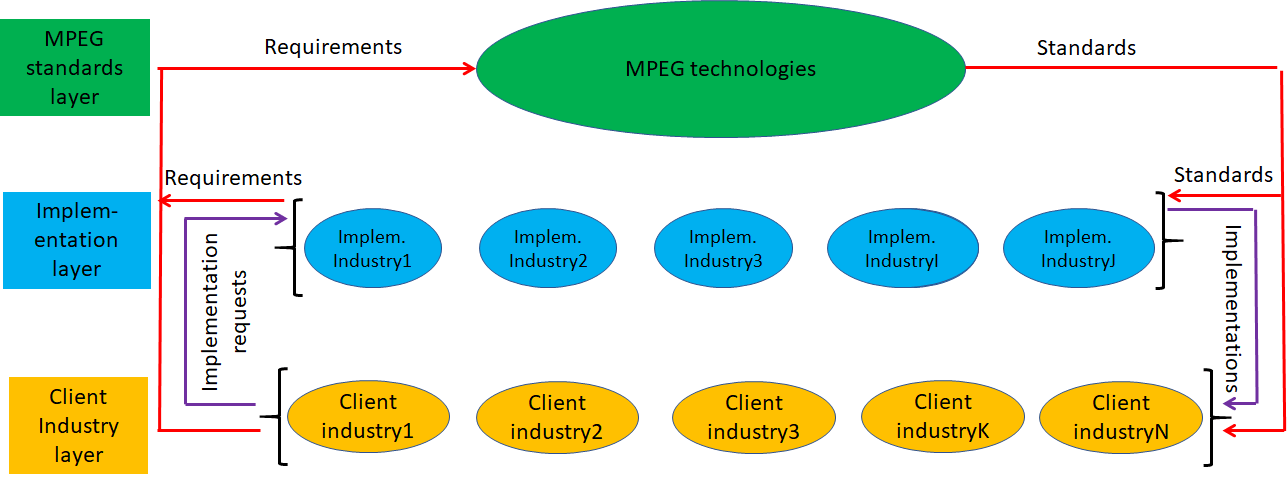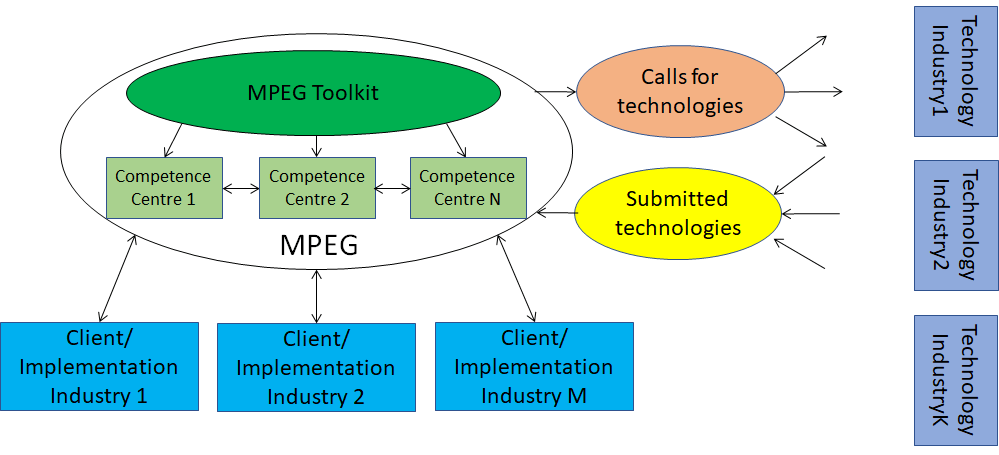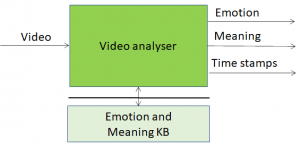Introduction
An ecosystem is composed of elements variously interconnected and variously dependent on one another. Standardisation is a particular type of ecosystem. Purpose of this article is to analyse the elements of the MPEG ecosystem and their relationships.
Standardisation in the past
In days long bygone, standardisation in what today we would call the “media industry” followed a rather simple process. A company wishing to attach a “standard” label to a product that had become successful in the market made a request to a standards committee whose members, typically from companies in the same industry, had an interest in getting an open specification of what had to be until then a closed system. A good example is offered by the video cassette player for which two products from two different companies, ostensibly for the same functionality – VHS and Beta – were approved by the same standard organisation – the International Electrotechnical Committee (IEC) and by the same committee – SC 60 B at that time.
Things were a little different in the International Telecommunication Union (ITU) where ITU-T (then called CCITT) had a Study Group where the telecommunication industry – represented by the Post and Telecommunication Administrations of the member countries, at that time the only ones admitted to the committee – requested a standard (called recommendation in the ITU) for digital telephony speech. ITU-T ended up with two different specifications in the same standard: one called A-law and the other called µ-law.
In ITU-R (then called CCIR) National Administrations were operating, or had authorised various entities to operate, television broadcasting services (some had even started doing so before WW II) and were therefore unable to settle on even a limited number of television systems. The only thing they could do was to produce a document called Report 624 Television Systems that collected the 3 main television systems (NTSC, PAL and SECAM) with tens of pages where country A selected, e.g., a different frequency or a different tolerance of the colour subcarrier than country B or C.
Standardisation, à la MPEG
Not unaware of past failures of standardisation and taking advantage of the radical technology discontinuity, MPEG took a different approach to standardisation which can be expressed by the synthetic expression “one functionality – one tool”. To apply this expression to the example of ITU-T’s A-law – µ-law dichotomy, if MPEG had to decide on a standard for digital speech, it would
- Develop requirements
- Select speech samples to be used for tests
- Issue a Call for Proposals (CfP)
- Run the selected test speech with the proposals
- Subjectively assess the quality
- Check the proposals for any issue such as complexty etc.
- Create a Test Model with the proposals
- Create Core Experiments (CE)
- Iterate the Test Model with the results of CEs
- Produce WD, CD, DIS and FDIS
The process would be long – an overkill in this case because a speech digitiser is a simple analogue-to-digital (A/D) converter – but not necessarily longer that having a committee decide on competing proposals with the goal of accepting only one. The result would be a single standard providing seamless bitstream interoperability without the need to convert speech from one format to another when speech moves from one environment (country, application etc.) to another.
If there were only the 10 points listed above do not make the MPEG process would not be much more complex than the ITU’s. The real difference is that MPEG does not have the mindset of the telecom industry who had decided A-law – µ-law digital speech 50+ years ago. MPEG is different because it would address speech digitisation taking into consideration the needs of a range of other industries who intend to use and hence want to have a say in how the standard is made: Consumer Electronic (CE), Information Technology (IT), broadcasting, gaming and probably more. Taking into account so many views is a burden for those developing the standard (actually, not necessarily) but the standards eventually produced is abstracted from the little (or big) needs that are specific of individual industries. Profiles and Level allow an industry not to be overburdened by technologies introduced to satisfy requirements from other industries that are irrelevant (and possibly costly) to an industry. Those who need the functionality, not matter what the cost, can do it with different profiles and levels.
Exploring the MPEG ecosystem
The article It worked twice and will work again contains a figure, reproduced below, that colourfully depicts with how MPEG has succeeded in its role of “abstracting” the needs of client “digital media” industries currently served by MPEG. The figure does not include other industries, such as genomics, that MPEG has begun to serve.

Figure 1 – MPEG and its client “digital media” industries
Figure 1, however, does not describe all the ecosystem actors. In MPEG-1 the Consumer Electronics industry was typically able to develop by itself (or found it more convenient to develop) the technology needed to make products that used the MPEG-1 standard. With MPEG-2 this was less the case as pointed out in the paragraph “A standard for all” in Why is MPEG successful? Today the industry implementing (as opposed to using or selling products based on) MPEG standards has grown to be a very important element of the MPEG ecosystem. This industry typically provides components to companies who actually manufacture a complete product (sometimes this happens inside the same company, but the logic is the same).
MPEG standards can be implemented using various combinations of software, hardware and hybrid software/hardware technologies. The choice for hardware is very wide: from various integrated circuit architectures to analogue technologies. The latter choice is for devices with extremely low power consumption, although with limited compression. Just about to come are devices that use neural networks. Other technologies are likely to find use in the future, such as quantum computing or even genomic technologies.
Figure 2 identifies 3 “layers” in the MPEG ecosystem, and the arrows show their relationships.

Figure 2 – MPEG, its Client Industries and Implementation Industries
Client industries in need of a standard provide requirements. However, the “Implementation layer” industries, examples of which have been provided above, also provide requirements. The MPEG layer eventually develops standards that are fed to the Client Industry layer that requested it, but also to the Implementation layer. Requests to implement a standard are generated by companies in the Client industry layer and directed to companies in the Implementation layer who eventually deliver the implementation to the companies requesting it. Conformance testing typically plays a role in assessing conformance of an implementation to the standard.
Figure 2, however, is not a full description of the MPEG ecosystem. More elements are provided by Figure 3 which describes how the MPEG process actually takes place.

Figure 3 – The MPEG process
The new elements highlighted by the Figure are
- The MPEG Toolkit assembling all technologies that have been used in MPEG standards
- The MPEG Competence Centres mastering specific technology areas and
- The Technology industries providing new technologies to MPEG by responding to Calls for Proposals (CfP).
In the early days the Implementation Industries did not have a clear identity and were largely merged with the Client Industries and Implementation Industries. Today, as highlighted above, the providers of basic technologies are well identified and separate industries.
Revisiting the MPEG process
Using Figure 3 it is possible to describe how the MPEG process unfolds (the elements of the MPEG ecosystem are in italic).
- MPEG receives a request for a standard from a Client Industry
- The MPEG Requirements Competence Centre develops requirements by interacting with Client Industries and Implementation Industries
- MPEG issues CfPs (Calls for technologies in the figure)
- Technology Industries respond to CfP by submitting technologies
- MPEG mobilises appropriate Competence Centres
- Competence Centres, coordinated by MPEG, develop standards by selecting/adapting existing technologies (drawn from the toolkit) and submitted technologies
- MPEG updates the toolkit with new technologies
It should be clear now that MPEG cannot be described by the simple “Standards Provider – Client Industry” relationship. MPEG is a complex ecosystem that works because all its entities play the role proper to them.
Dividing MPEG by Client Industries means losing the commonality of technologies. Dividing MPEG by Implementation Industries makes no sense, because in principle any MPEG standard must be implementable with different technology. Dividing MPEG by Competence Centres means losing the interaction between them.
Conclusions
MPEG is a complex ecosystem that has successfully operated for decades serving the needs of the growing number of its component industries. As much as you would not allow a child to open a toy with complicated gears inside just to see “how it works”, industry should not allow apprentice sorcerers to undo this wonderful ecosystem called MPEG.
Posts in this thread (in bold this post)
- The MPEG ecosystem
- Why is MPEG successful?
- MPEG can also be green
- The life of an MPEG standard
- Genome is digital, and can be compressed
- Compression standards and quality go hand in hand
- Digging deeper in the MPEG work
- MPEG communicates
- How does MPEG actually work?
- Life inside MPEG
- Data Compression Technologies – A FAQ
- It worked twice and will work again
- Compression standards for the data industries
- 30 years of MPEG, and counting?
- The MPEG machine is ready to start (again)
- IP counting or revenue counting?
- Business model based ISO/IEC standards
- Can MPEG overcome its Video “crisis”?
- A crisis, the causes and a solution
- Compression – the technology for the digital age
- On my Charles F. Jenkins Lifetime Achievement Award
- Standards for the present and the future

